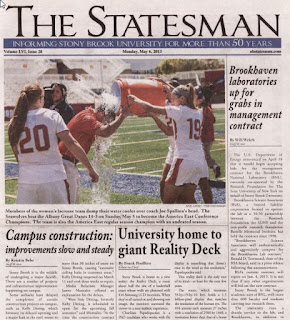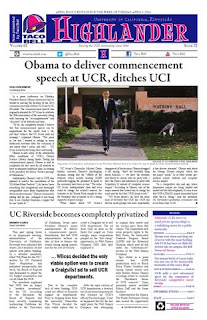Suzanne's Blog for her class - Mass Communication 4003: Media Law and Ethics (for the Mass Communications Degree at Southern Arkansas University)
Wednesday, April 11, 2018
Brief #9: College Media
The phrase "college media" can mean many things, from student or university blogs, to social media posts, to the school newspaper or TV studios. I decided to focus my post on U.S. college newspapers (many of which are online-only, like our own "The Bray"). I knew very little about college newspapers, so this was an interesting fact-digging assignment for me. I worked on my junior high school paper in 9th grade, and I drew some cartoons for my school paper in Palomar Community College in 1980. I wrote some articles for The Bray last semester. I've been at many universities, due to my husband's job, and some of their papers were good, and some not so good. Other than that, I know zilch about school papers. Video
From what I've been able to tell with my online research, today's college newspapers face three main challenges: whether to keep printing or move online entirely (or to blogs and social media); how to get funding in the face of budget cuts; and facing censorship. Video
Unlike professional newspapers, school papers are usually funded by the university (via student fees), or they have advertisers, or both. These papers are always free, so they can't charge a subscription fee. Our paper here at SAU pays the students for articles and photos, which I was surprised to learn. I thought school papers were either put out by a particular journalism class, or they were run by volunteers (like a campus club), which is how papers are done in high schools and middle schools (at least, as far as I remember). On the other hand, many colleges no longer have journalism degrees or even journalism classes. Our major is "Mass Communication" and focuses on online media and PR as much as journalism. However, the writers and photographers of the school paper are not necessarily Mass Comm majors. Video
I was shocked that university papers are having financial cutbacks because I thought they were well-supported by the colleges. Apparently when colleges try to cut costs, the school paper budget is one of the things they do slash. I suppose if a school paper is not popular with the students, and not well read by others in the community, and there is no Mass Comm or Journalism degree, they shouldn't charge students extra money for it. That makes sense. Unfortunately, I think that funding is cut even when the papers have many readers.
Many school papers stopped printing an actual paper and have gone digital. Sometimes it's because of printing costs, but also it's because today's students are more comfortable with digital newspapers. Also, today's students tend to be environmentally conscious, so it makes sense that they would rather not kill more trees or have to recycle newspapers instead of having a digital paper (even if going digital is not necessarily any more ecologically-friendly.) Some college newspapers are using social media to help bring in more readers. Video
I was even more shocked to learn that some college administrators try to control what the newspaper talks about. Here at SAU, the administration has a "hands off" policy when it comes to the paper. The paper isn't even hosted on the SAU website. It's completely independent and student-run. The advisor only advises and doesn't tell the editor or reporters what to do. The first amendment is alive and well here in Southern Arkansas.
College newspapers also vary widely in their writing styles, resources and circulation numbers. Top universities like Harvard train their students in newspapers and magazines that are very similar to real-world major newspapers. Some colleges have moved their operations entirely to blogs or social media. I suppose that's the wave of the future in student newspapers. Video
Subscribe to:
Post Comments (Atom)








No comments:
Post a Comment